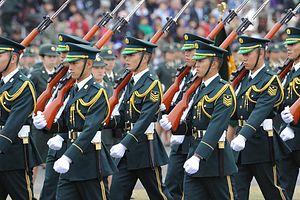On March 3, Japan’s Prime Minister Shinzo Abe announced to the Diet, with little accompanying fanfare, an official break with his predecessors’ policy of restricting defense spending to 1 percent of Gross Domestic Product (GDP). This break is notable for a variety of reasons and is a decisive step toward achieving the Liberal Democratic Party’s defense revitalization goals.
English-language resources hardly address the subject, but the 1 percent policy (which is not law) was, next to the constitution itself, one of the most tenacious obstacles restricting meaningful defense reform in Japan. Like the glacial five-year Midterm Defense Plan system Japan currently utilizes for defense spending, the 1 percent restriction was an antiquated feature that needed to go. Its origins, stretching back to 1976 and reflecting a Japan seeking to halt runaway Cold War defense expenditures, worked for Japan’s own particular situation and era; that of a Japan which turned toward a Japan-based U.S. forward presence as a main deterrent to the Soviet Union, abstaining from both expensive standing armies and pricey nuclear forces. Times have clearly changed.
There is only one immediate implication of this policy adjustment: we can expect Abe to raise the defense budget as high as he and his administration dare beyond 1 percent of GDP. Despite the removal of this significant barrier, Japan’s emaciated defense budget still faces multiple hurdles if it is to grow in order to meet East Asia’s rapidly changing defense environment. First and foremost of these hurdles is the power and entrenchment of the Ministry of Finance. While the Japanese constitution clearly gives the Diet the role of passing a budget, whether or not that budget survives the process is up to the Ministry of Finance.
In reality, the Ministry of Finance, through its veiled bureaucratic processes, exercises particularly strong control over what gets funded versus what does not. Japan’s usual budgetary process involves the Cabinet giving the Ministry of Finance its budget requests, whereupon the Ministry makes cuts and changes and incorporates policies that may remain behind from previous cabinets, unbeknownst to the current Cabinet. Put in a simplified form, the budgetary process has predictably repeated itself, with little change, over and over in past decades, like a bibliophile reassured by the comforting embrace of an old book: the Cabinet hands the Ministry of Finance optimistic budgeting desires, whereupon they are considered, edited, and returned with an apology and an explanation that the Cabinet’s wishes could not possibly be met given precedent and available funds. The Ministry hands the Cabinet an edited budget, complete with all pertinent policy references and explanations (such as the 1 percent limitation), and wishes the Cabinet luck in the Diet. The prime minister grits his teeth, sends the budget to the Diet, at which time his Lower House majority passes the budget and sends it to the Upper House, starting a ticking clock which, after expiration, ends in a budget approved in the form sanctioned by the Ministry of Finance.
This time, however, Abe has an ace in the hole: his deputy prime minister, and former prime minister himself, Taro Aso, doubles as his finance minister, head of the Ministry of Finance. With such influence at his disposal, it is likely Abe is now able to place significant pressure on the Ministry of Finance after the Cabinet submits its budgets. This helps explain the notable changes in Japanese defense spending regarding budgets under the Abe administration, despite the 1 percent limit; now with no limit, the Ministry of Finance has a great deal of work ahead of it.
Future strategic impacts of the change are noteworthy. First, Abe and the Liberal Democratic Party are now poised to seize any and all defense-focused domestic political momentum in Japan. The Japanese polity, for a variety of reasons, is politically apathetic to defense to a degree unseen in many countries. However, it has shown signs of “waking” to the changing defense environment in which Japan finds itself, especially younger Japanese who, as of last year, have been granted suffrage as early as 18 years old. The Liberal Democratic Party, alone, stands ready to reap whatever harvest of voters its emphasis on defense brings. Further, the door to a nuclear-armed Japan has cracked a bit farther open. Without an artificial budgetary constraint, Japan is free to procure what its Cabinets can wring from the Ministry of Finance — including expensive equipment, like nuclear systems. This newfound potential could also explain Japan’s hesitation to be as vocal about anti-nuclear weapons as it has been in the past. Finally, and perhaps most significantly, regional adversaries can no longer mathematically determine the maximum level of Japanese defense potential. From here on out, Japan is more prepared to react faster and with more spending to growing defense concerns.
While Japan’s Cabinet still faces significant challenges to get the defense spending it wants, the removal of the 1 percent policy, at least in this administration, is a seminal event that signals significant change ahead.
Major John Wright is a U.S. Air Force officer, pilot, and a Mike and Maureen Mansfield Fellow. He is currently serving as Japan Country Director, International Affairs, Headquarters Pacific Air Forces, Honolulu, HI. The views expressed in this article are his own.

































